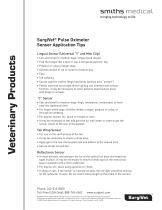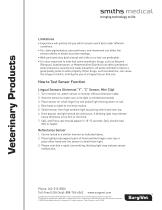
Catalog excerpts

Veterinary Products SurgiVet® Pulse Oximeter Sensor Application Tips Lingual Sensor (Universal “Y” and Mini Clip) • Cats and small to medium dogs: tongue (pink tissue). • Fold the tongue like a taco or use a wet gauze pad over top. • Prepuce or vulva of larger dogs. • Achilles tendon of cat or small to medium dog. • Ears. • Toe webbing. • Can be used for exotics (thigh) and birds (axillary area “armpit”). • Please note that very bright direct lighting can interfere with sensor function, it may be necessary to cover patients head (sensor area) with drape or a towel. “C” Sensor • Cats and small to medium dogs: thigh, metatarsal, metacarpal, or hock near the saphenous vein. • For larger breed dogs: Achilles tendon, tongue, prepuce or vulva, or through toe webbing. • For equine, bovine, etc. place on tongue or ears. • It may be necessary to wet and part the fur with water in order to get the sensor closer to the skin of the patient. Tail Wrap Sensor • For use on the ventral base of the tail. • It may be necessary to shave a small area. • Apply gel to the non-illuminated side and adhere to the shaved area. • Secure straps around tail. Reflectance Sensor • In most animals, wet and part the fur at the ventral tail base and wrap (not tape) in place. It may be necessary to shave a small spot on the ventral tail base in patients with a thick undercoat. • For equine, etc. place along gumline or cheek. • In dogs or cats, if the sensor is inserted rectally, the red light should be shining on the sphincter muscle. Do not insert entire length of the probe in the rectum. Phone: 262-513-8500 Toll-Free (USA Only): 888-745-6562 SurgiVet and the Smiths Medical design mark are trademarks of the Smiths Medical family of companies. The symbol ® indicates the trademark is registered in the U.S. Patent and Trademark Office and certain other countries. © 2008 Smiths Medical family of companies
Open the catalog to page 1
Veterinary Products Limitations • Experience will quickly tell you which sensors work best under different conditions. • Fur, dark pigmentation, poor perfusion, and movement can affect the sensors ability to obtain accurate readings. • Well-perfused sites (pink tissue) with little or no hair are preferable. • It is also important to note that some anesthetic drugs, such as Xylazine (Rompun), Acepromazine, or Medetomidine (Domitor) can affect peripheral pulse pressures causing very weak pulsations. All pulse oximeters require a good quality pulse to work properly. Other drugs, such as...
Open the catalog to page 2All Smiths Medical Surgivet catalogs and technical brochures
-
Diana™
5 Pages
-
IV Solutions
5 Pages
-
SuperCath® 5
2 Pages
-
Plum 360™
7 Pages
Archived catalogs
-
Animal Consumables
2 Pages
-
Veterinary Equipment and Disposables
100 Pages
-
V3395 TPR Monitor
2 Pages
-
Classic T3 Vaporizer
2 Pages
-
SurgiVet® V9004
2 Pages
-
SurgiVet® V8401
2 Pages
-
Advisor® Vital Signs Monitor
2 Pages
-
Equipment Catalog
50 Pages
-
Ear Lavage Catheter
1 Pages
-
Heimlich One-Way Valve
1 Pages
-
Thoracic Drainage Catheter
1 Pages
-
Foal Tracheal
1 Pages
-
Chest Drainage Tube
1 Pages
-
Equator Sales Brochure
2 Pages
-
Consumables Catalog
38 Pages
-
Equipment Catalog - 2012
50 Pages






























